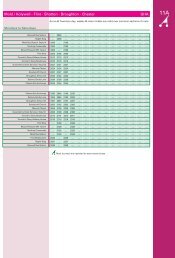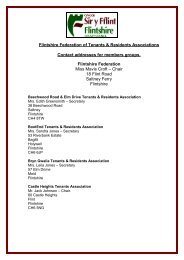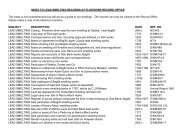Caerwys Eng.indd - Flintshire County Council
Caerwys Eng.indd - Flintshire County Council
Caerwys Eng.indd - Flintshire County Council
Create successful ePaper yourself
Turn your PDF publications into a flip-book with our unique Google optimized e-Paper software.
School days<br />
The first record of a school in the village is in 1813, when the<br />
small cottage on Drover’s Lane was described as a ‘commodious<br />
schoolroom’. This school was funded by a grant from the National<br />
School Society and by subscription from parents (when they could<br />
afford it) and local landowners.<br />
Pupil numbers must have grown because, in 1833, a new school was<br />
built on the corner of the High Street and Pen-y-cefn Road. It is now<br />
a private house but is still clearly recognisable<br />
as the school bell tower is still in place.<br />
By the late 20th century this school building<br />
was in need of considerable modernisation and<br />
was too small to suit contemporary teaching.<br />
Ysgol yr Esgob was built opposite the church and<br />
opened in 1993.<br />
Whilst the fabric of the building and teaching<br />
styles have changed considerably, pupils<br />
today still have much in common with their<br />
predecessors. Nature walks and learning about<br />
the local area were an important part of<br />
teaching 60 years ago, as Annette Jones’<br />
exercise book illustrates. Pupils today still enjoy<br />
walks in Maesmynan woods and are proud and<br />
knowledgeable about their local heritage.<br />
Evacuees<br />
In 1939, following the outbreak of the Second<br />
World War, pupil numbers rose dramatically<br />
with the arrival of many evacuees. The docks<br />
on both sides of the Mersey were targets<br />
for enemy bombers so evacuees came from<br />
Wallasey and Birkenhead as well as Liverpool itself. In 1944, 22<br />
children from London were also admitted to the school, evacuated<br />
when London was suffering heavy bombing.<br />
The experiences of the evacuees varied considerably, depending on their<br />
circumstances. Some children were billeted with families and went to<br />
the village school. Many Catholic children were housed at Bryngwyn<br />
Hall, along with their teachers and taught separately in <strong>Caerwys</strong> Town<br />
Hall. Whilst some were homesick and found it hard to settle, many<br />
seemed to thoroughly enjoy country life and<br />
some settled in the town after the war.<br />
"My aunt Joan was evacuated from<br />
Sacred Heart School, Liverpool, to<br />
<strong>Caerwys</strong>. She stayed with Mr and Mrs<br />
Jones, who were friends of the family,<br />
and was very happy there. After the<br />
war, she returned many times for<br />
holidays and the Jones became like<br />
aunt and uncle to her own sons."<br />
Maureen Roach









